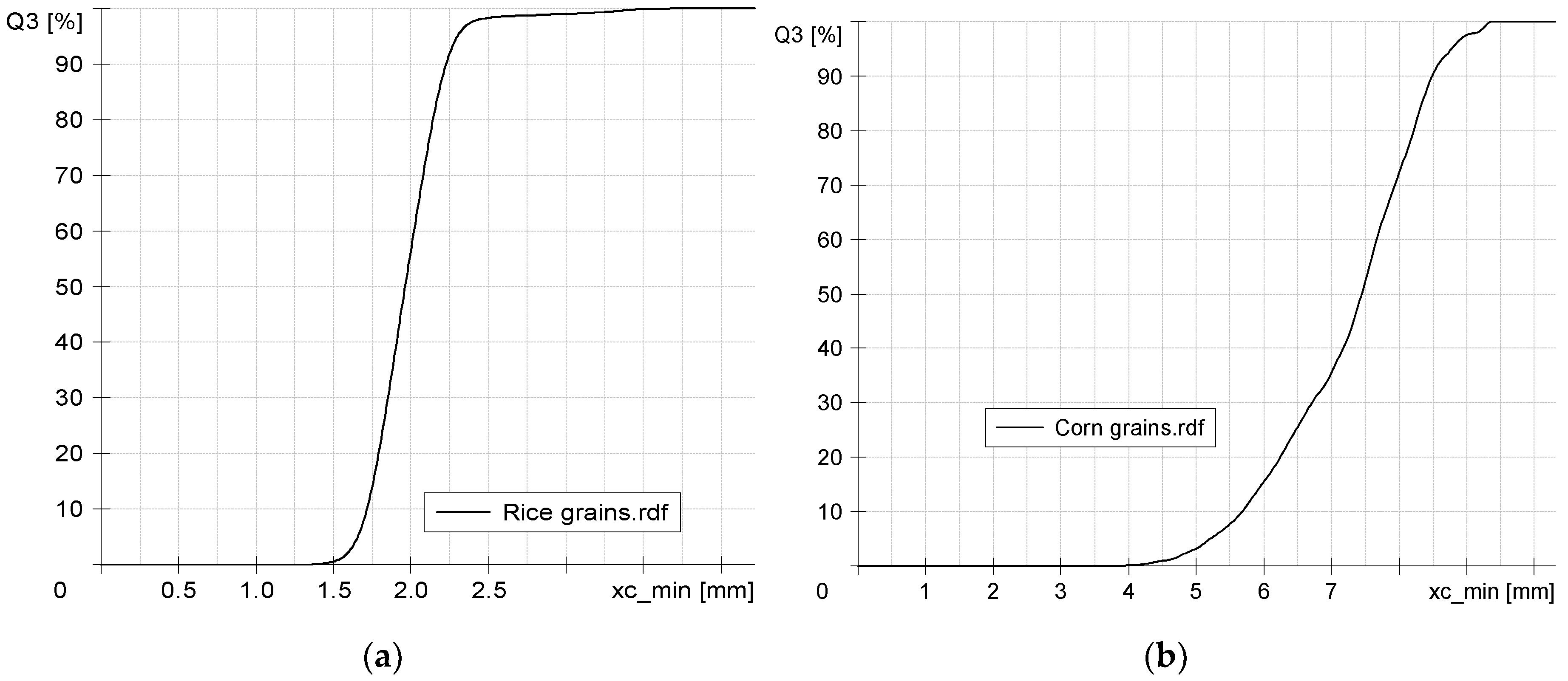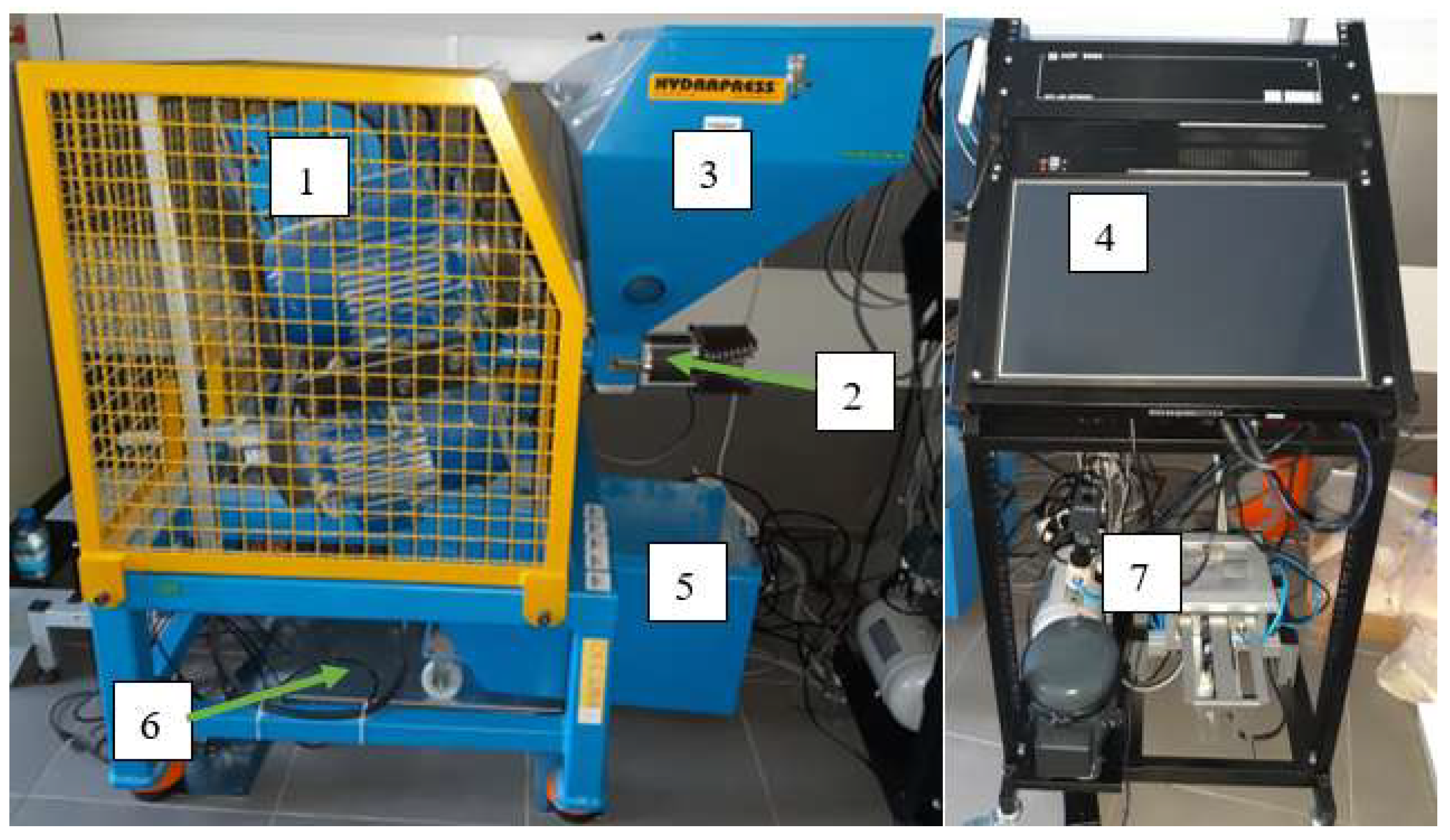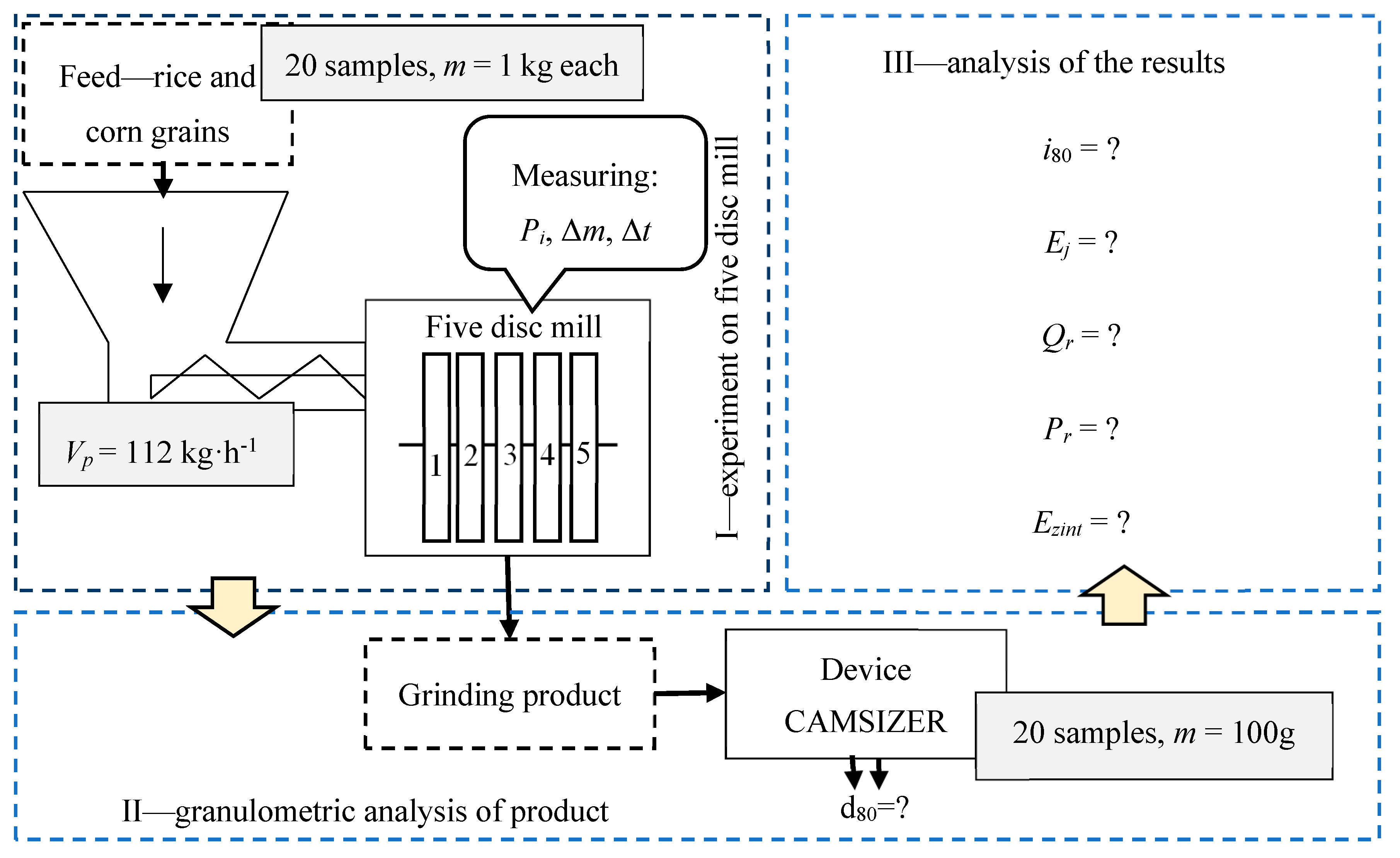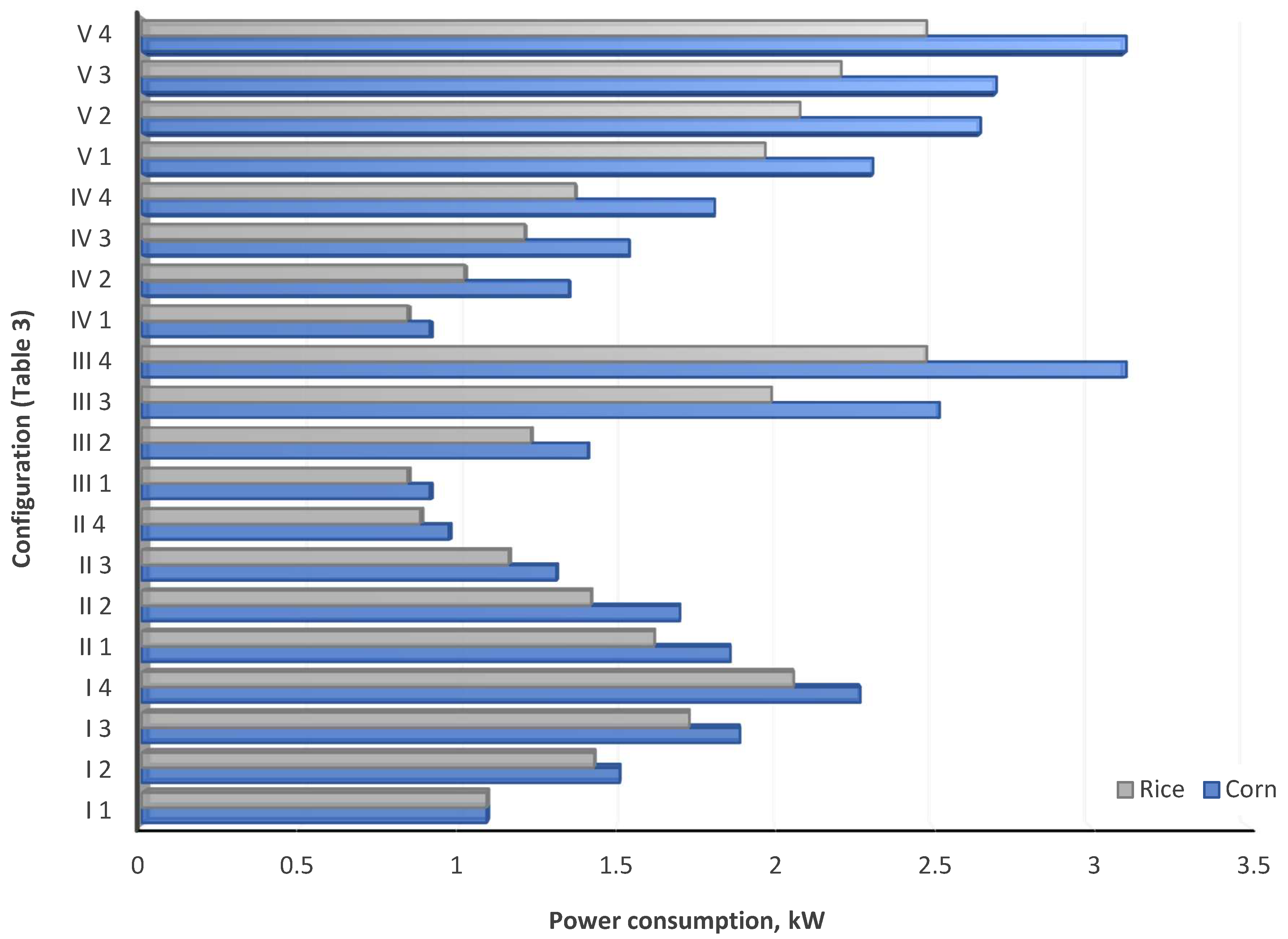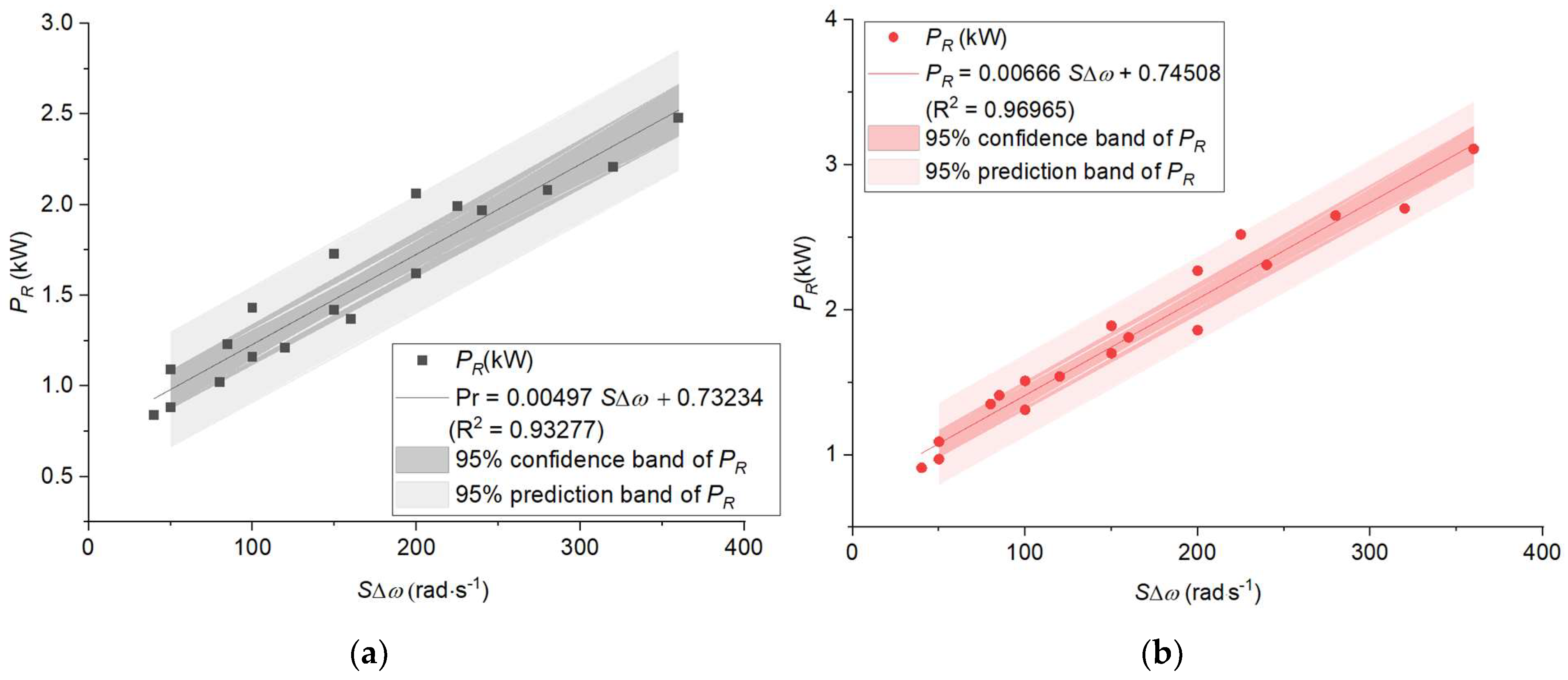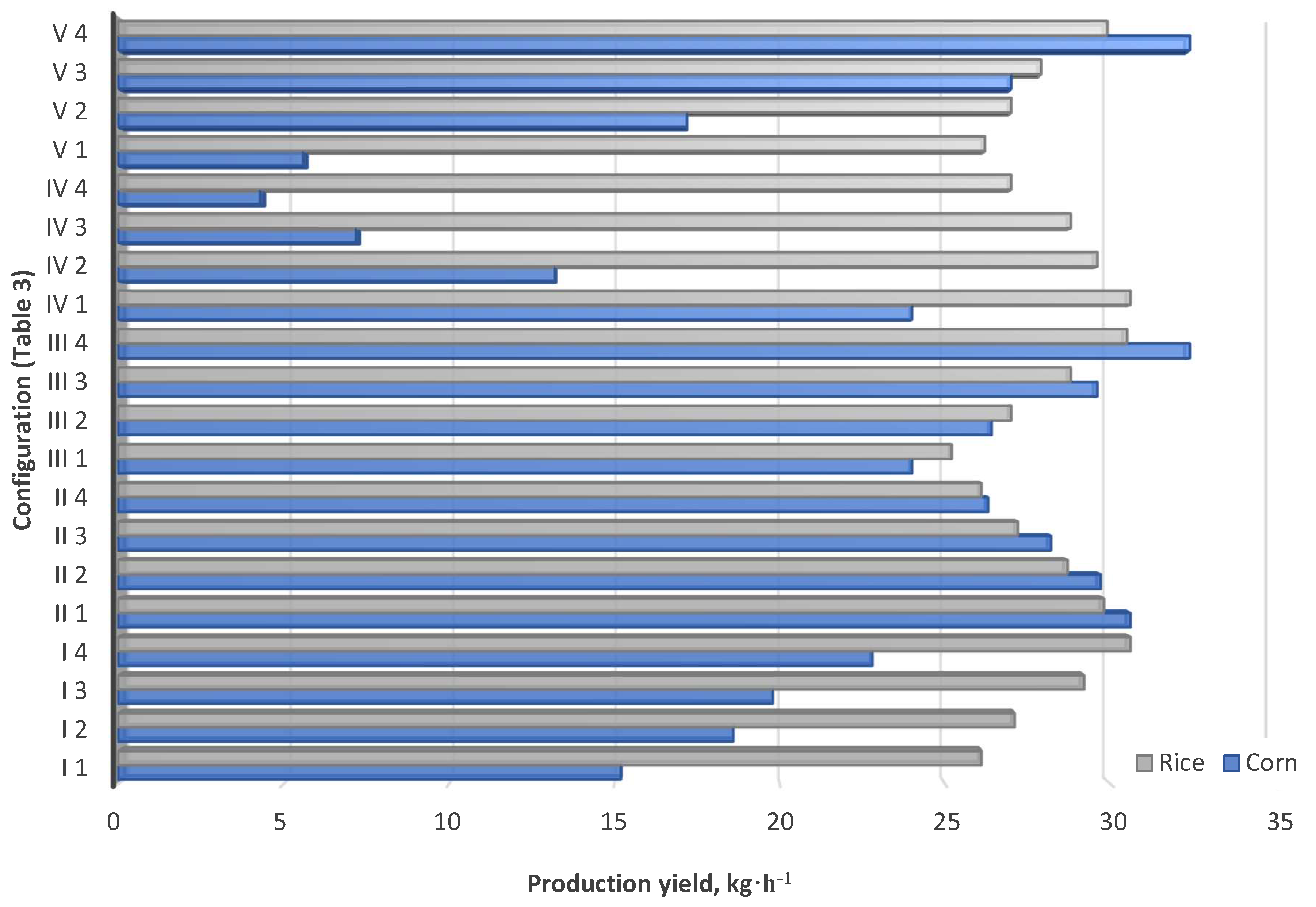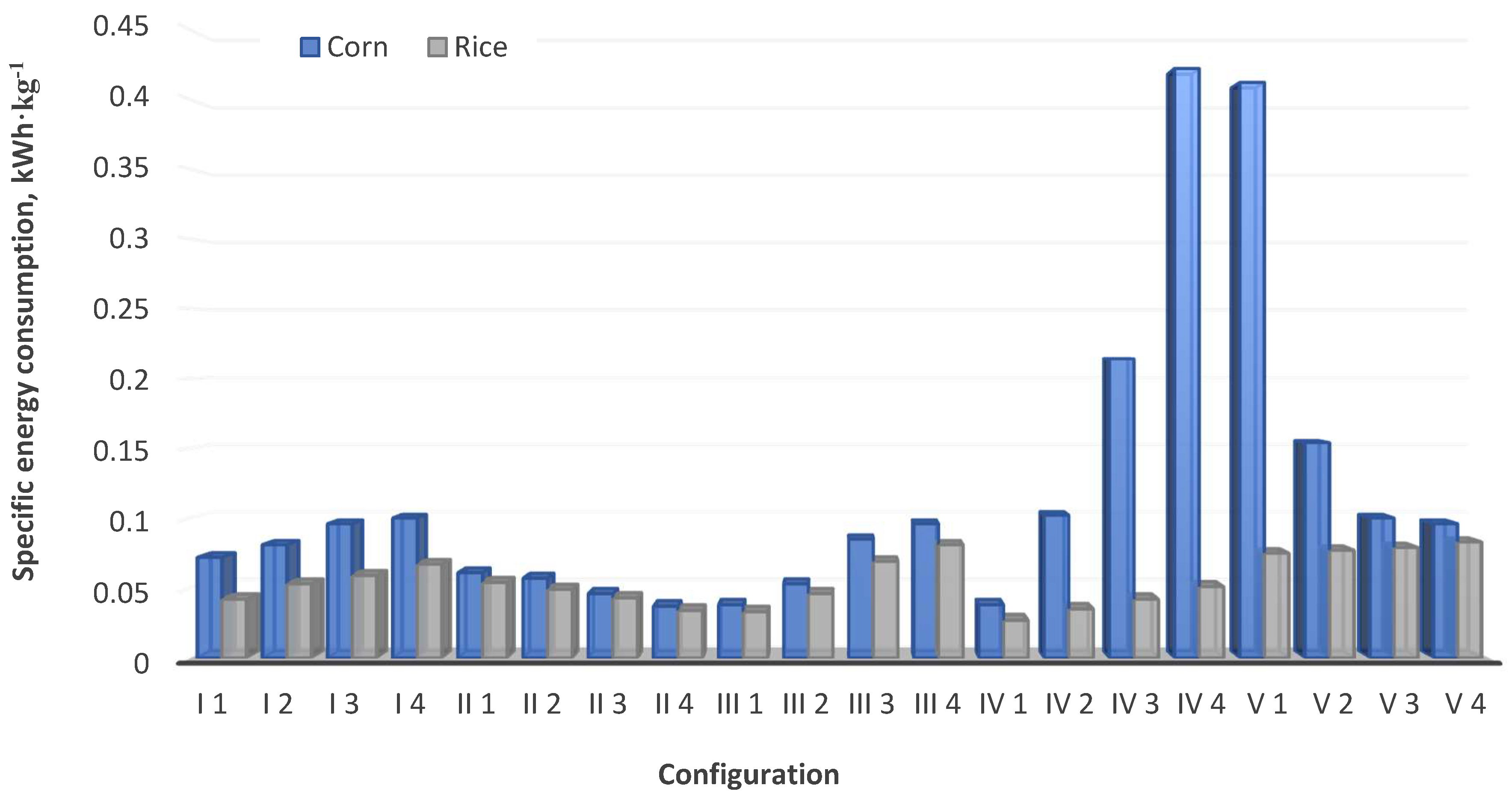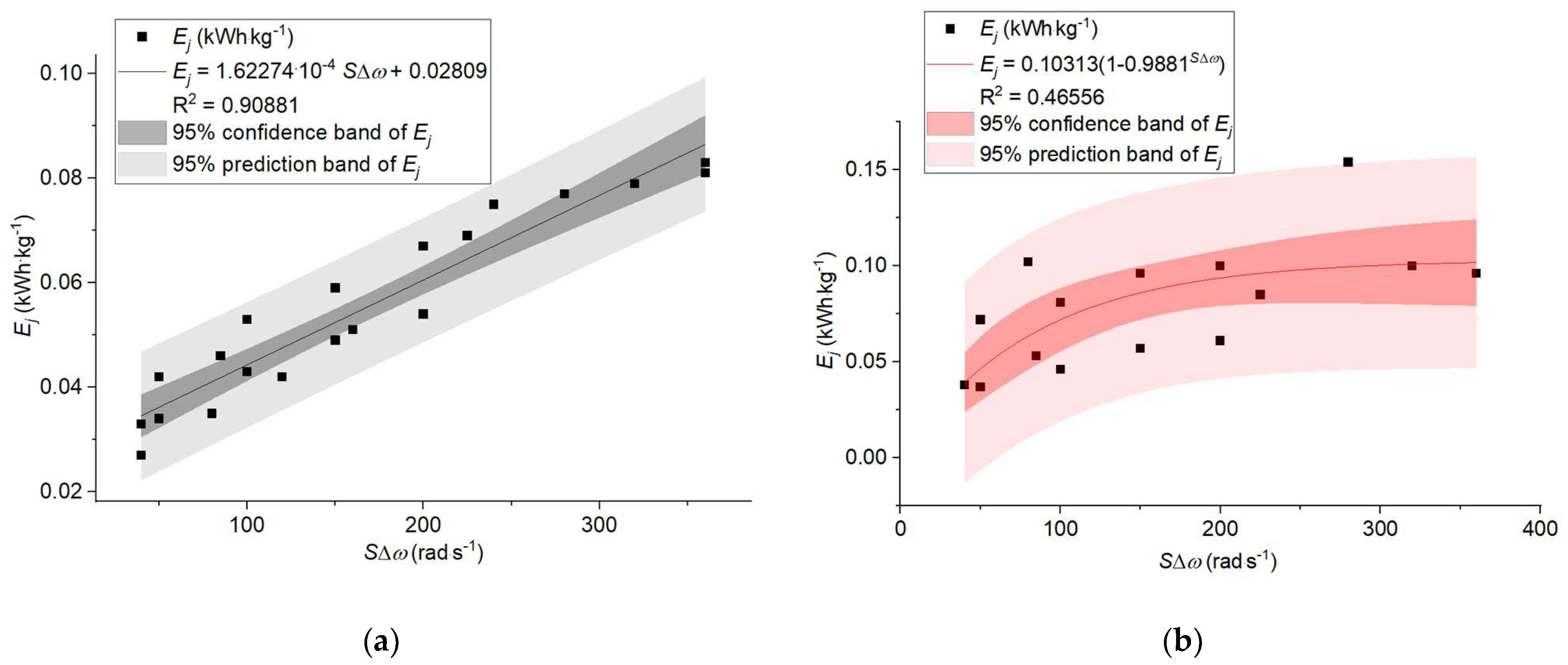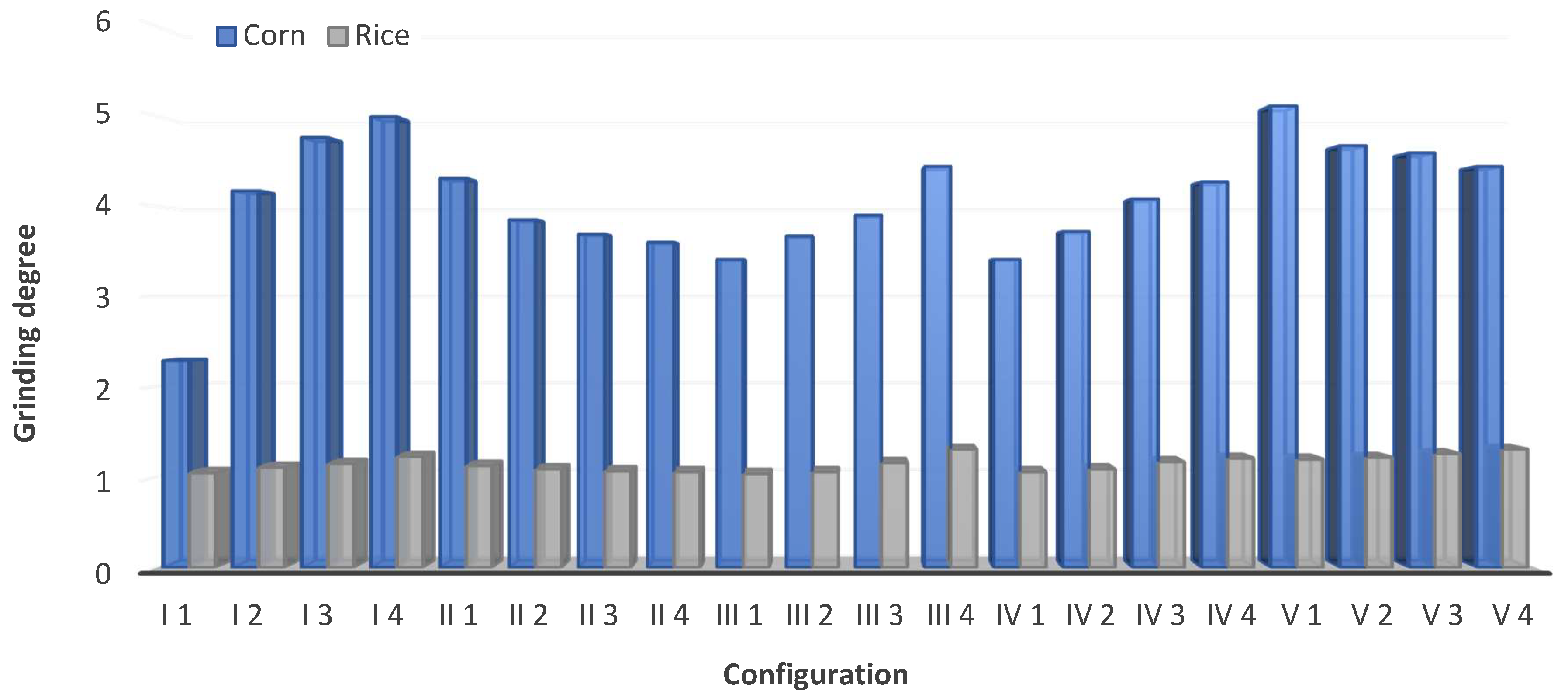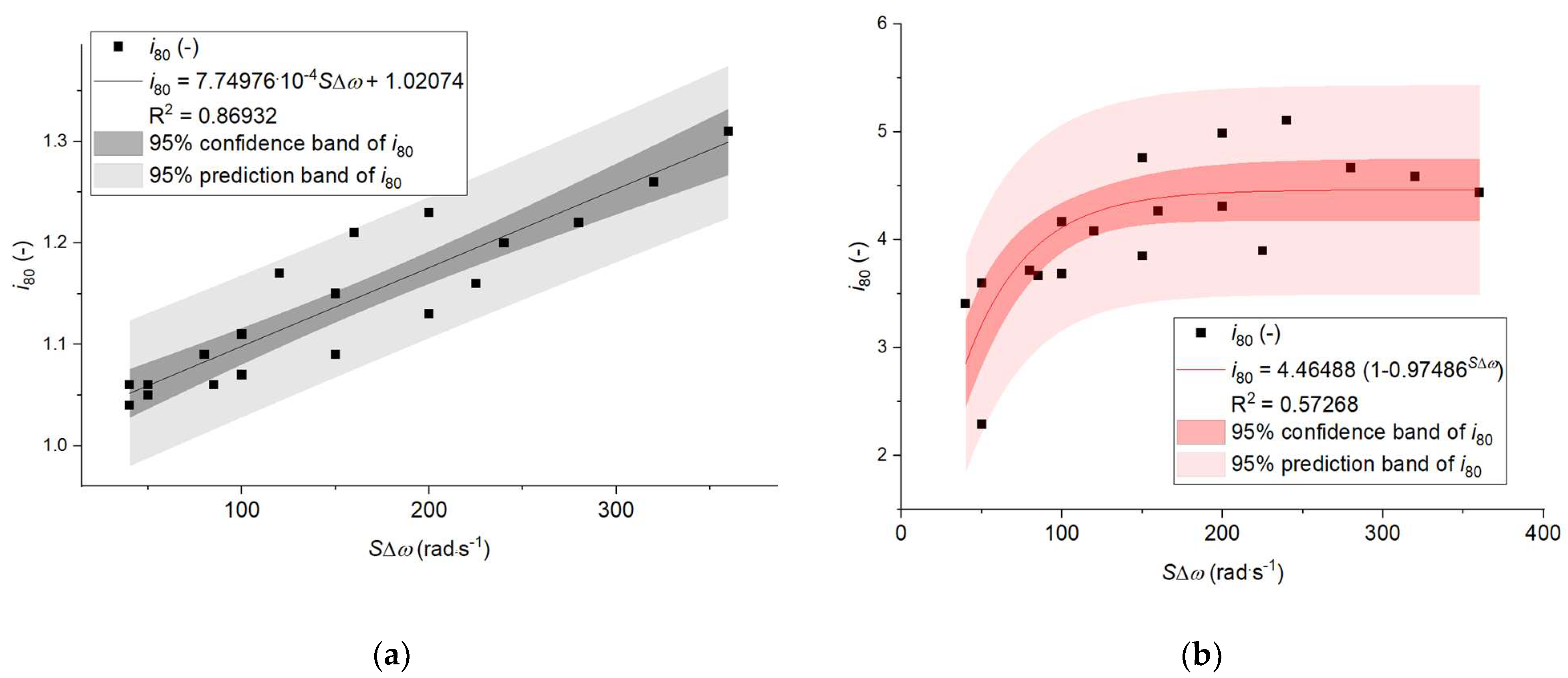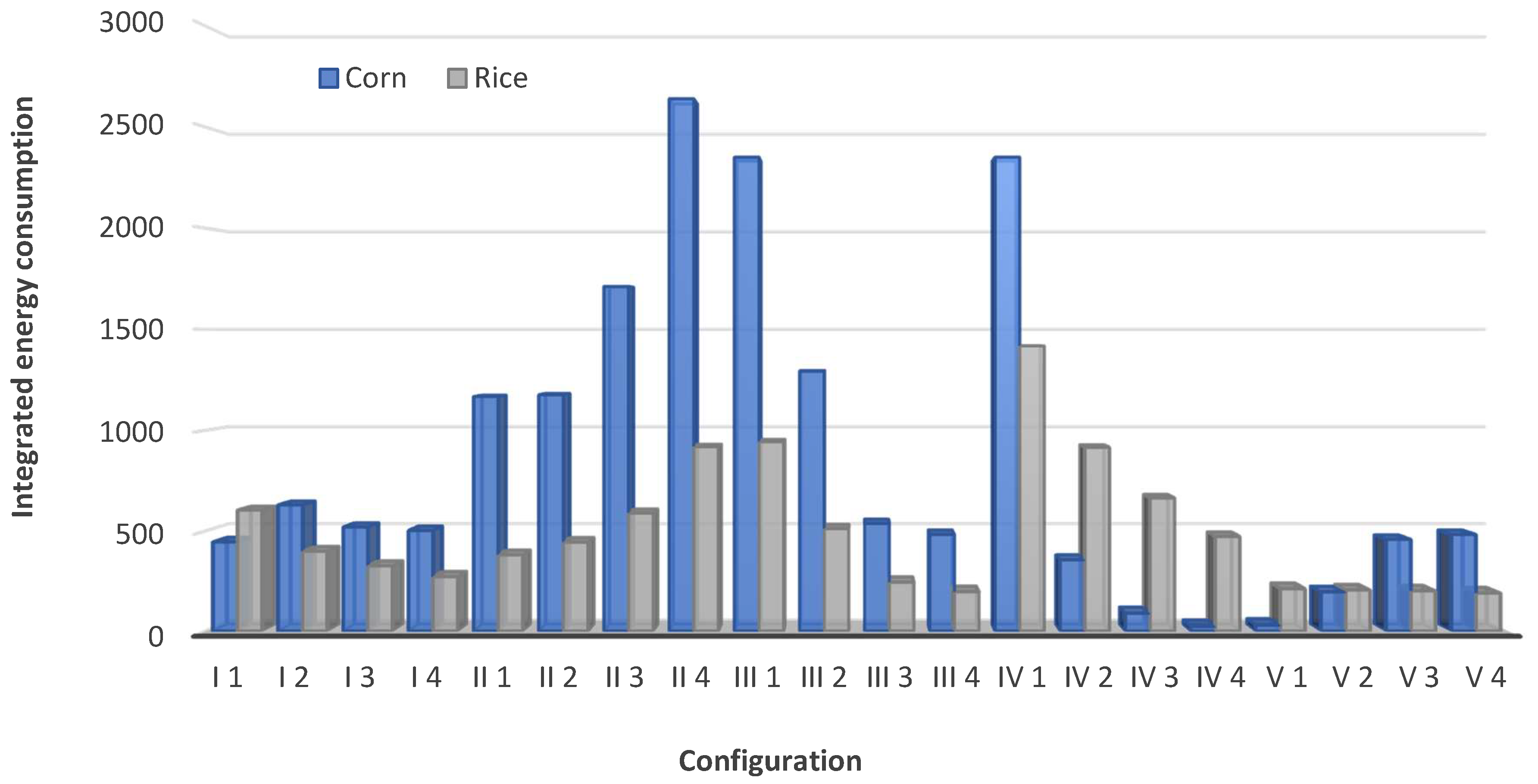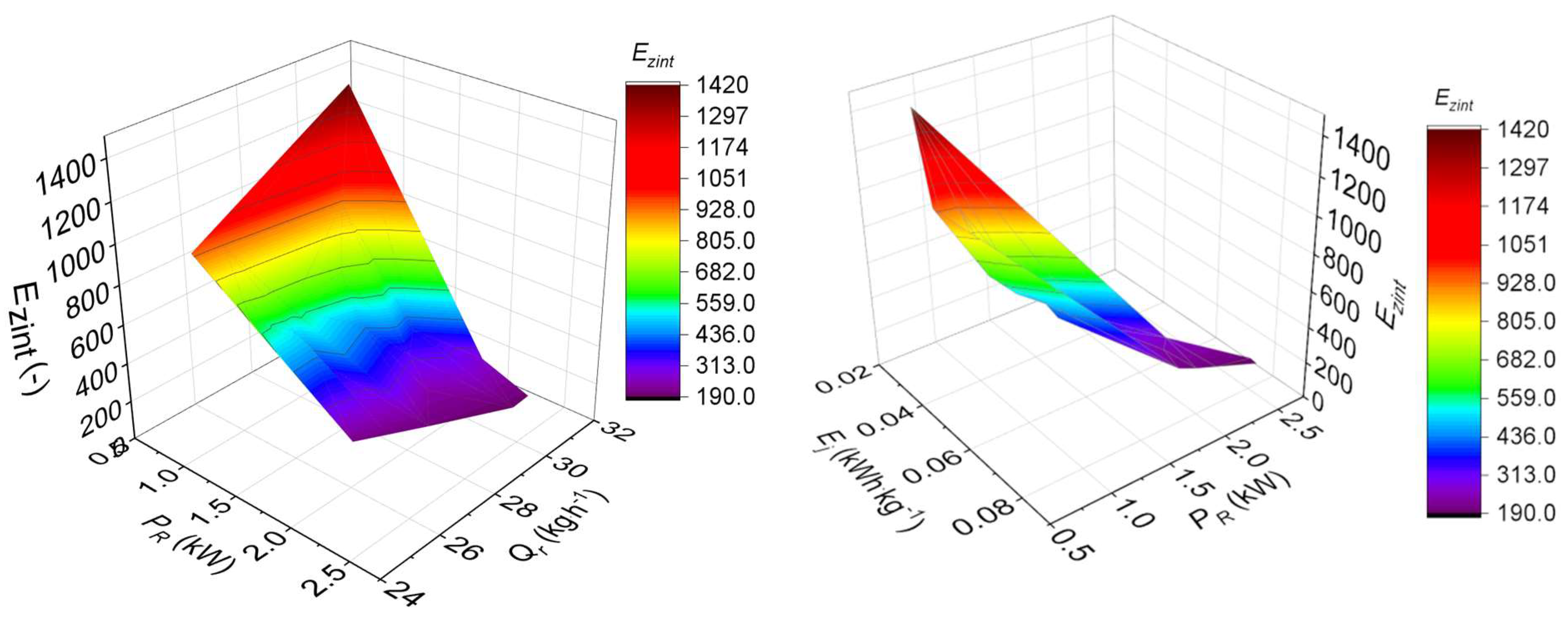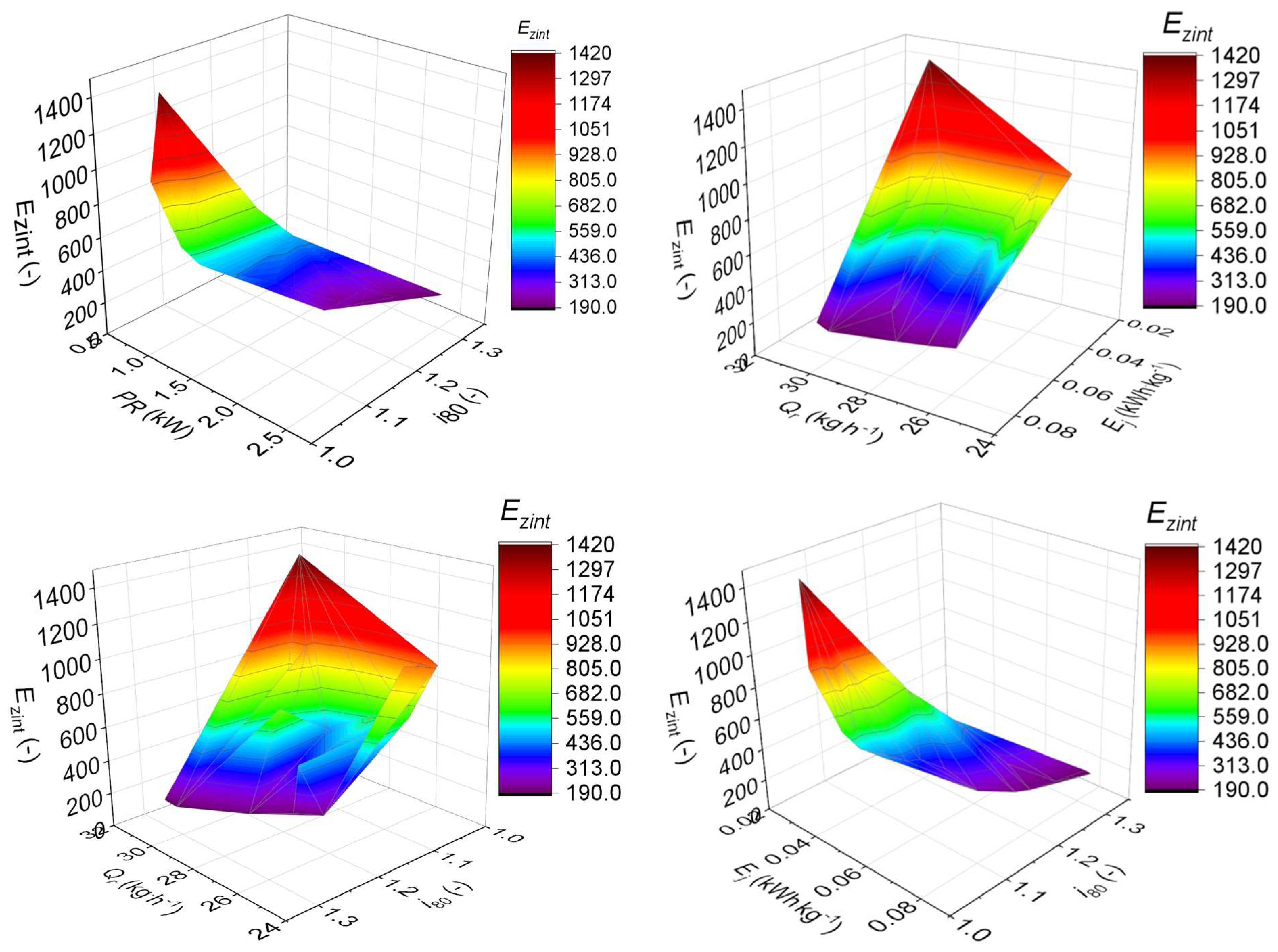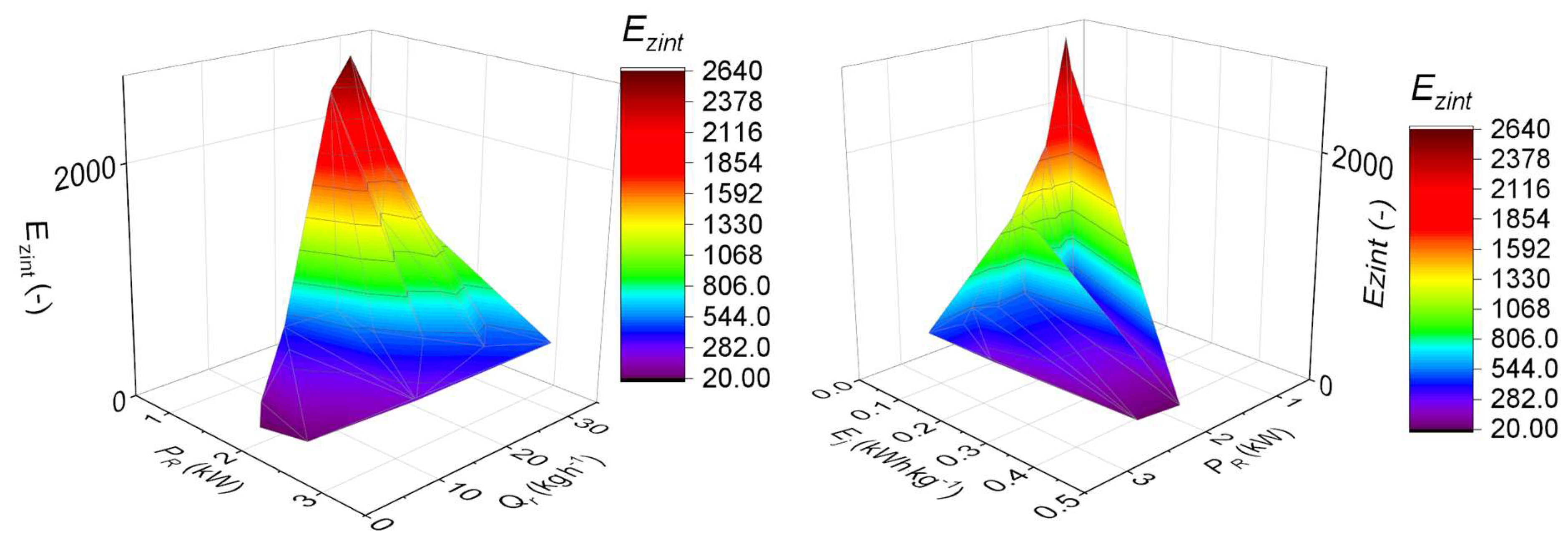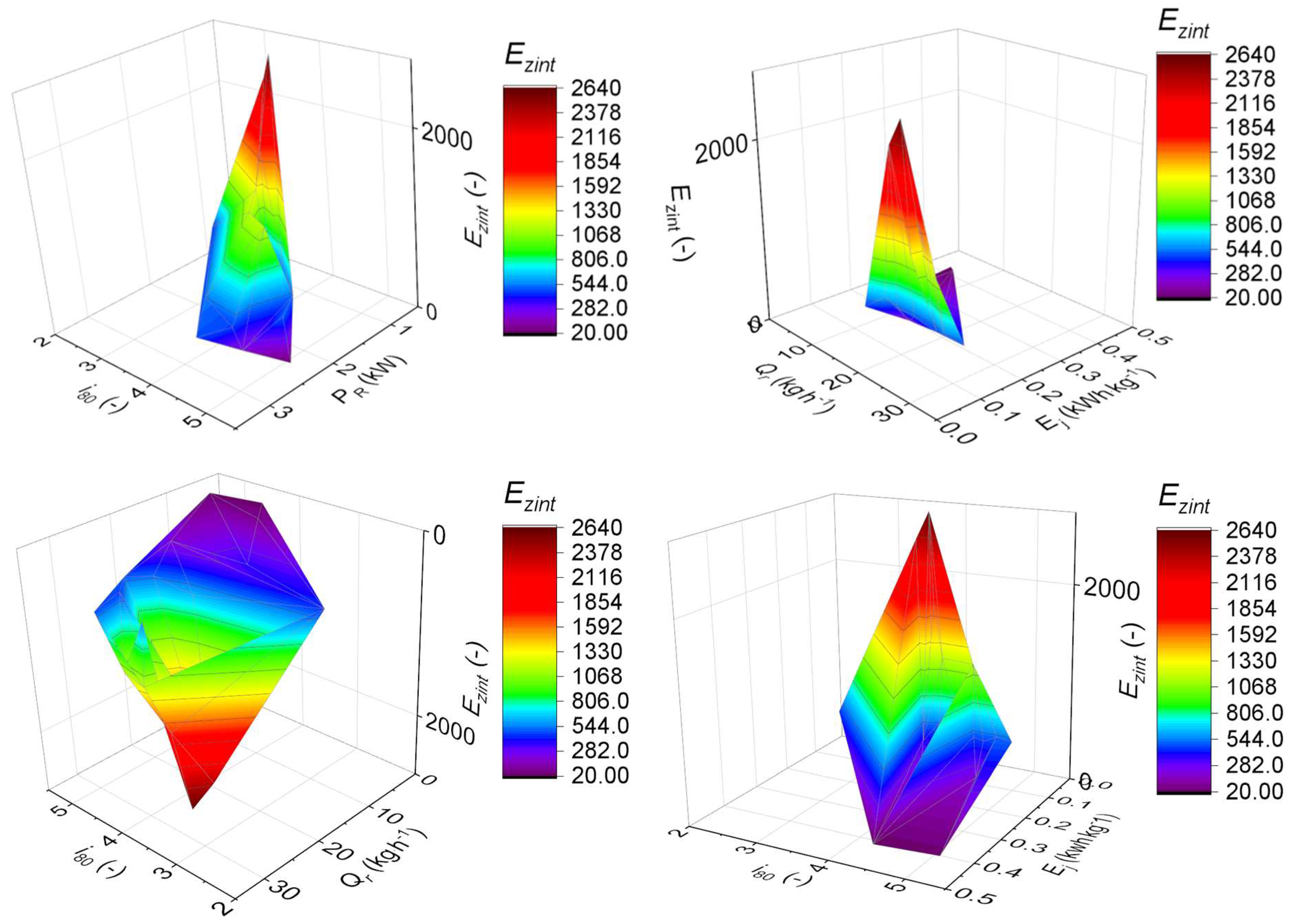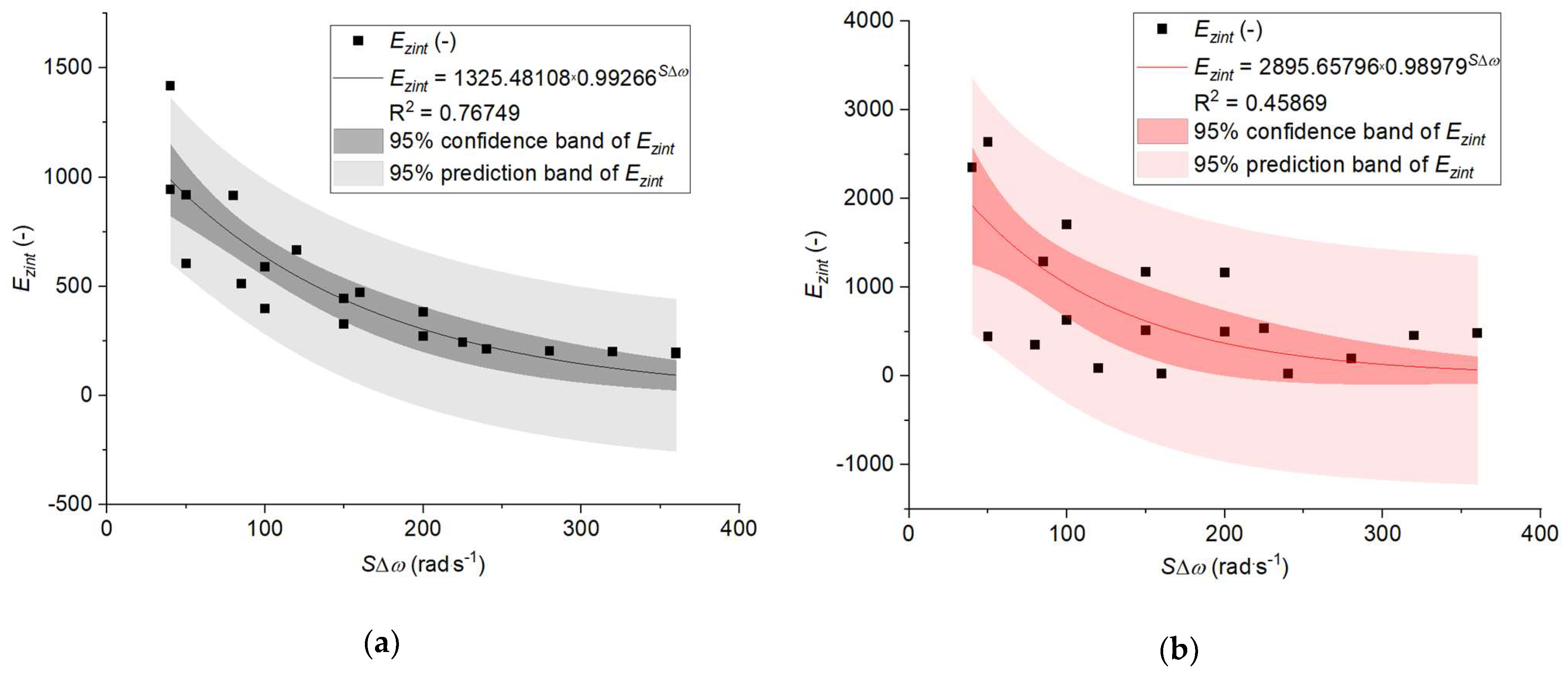1. Introduction
The simplest and the most common method of biomass utilization is its combustion, e.g., in the boilers of a power station [
1]. There are also other forms of energy production that are increasing in popularity, including: gasification, biomethane production, esterification, the acquisition of bioethanol, etc. [
2,
3]. Depending on the energy purpose and type of biomass, the comminution process will vary—in particular, in terms of the desired final dimension of the comminution product [
4,
5]. In the case of anaerobic digestion, biomass is comminuted to several millimeter fractions [
4]. Pellets are usually made of fibrous biomass ground to 2–4 mm or smaller, depending on the briquetting machine design, while briquettes, from particles smaller than 10 mm [
6]. In the production of biofuels, in turn, biomass particles should be in the range of 100–500 μm, and for gasification and direct combustion processes, below 100 μm [
4]. Previous research has shown that the smaller the biomass particles are used for energy purposes, the greater the efficiency and easier control of biomass thermochemical transformation processes [
5].
Acquiring energy from biomass requires its earlier preparation: drying, grinding, palletizing, etc. [
7]. These procedures require certain energy inputs (costs) which significantly decrease the energy and environmental balance in the entire lifecycle of the energy material (wood, grain biomass, etc.) [
8,
9,
10,
11,
12,
13]. According to the idea of sustainable development concerning the design of systems, devices, and processes, in three areas—the environment, society, and economy—the biomass processing lines should be characterized by the lowest possible energy consumption and environmental impact [
14,
15]. It also aims to improve the competitiveness of biomass fuels in relation to conventional fossil fuels [
16,
17].
Before being used for energy purposes, energy media need to be properly prepared, e.g., their dimensions need to be reduced by means of grinding [
2]. Roller, drum, ball, hammer, and disc mills are used to grind granular biomaterials (biomass grains) [
7,
18]. Tests have shown that the best relations between product quality, yield, and grinding energy consumption occur for hammer and disc mills [
2,
7]. The quality of the grinding product is most often determined by the grinding degree, which is defined as the ratio of the characteristic dimensions of the particles before and after size reduction [
19,
20]. Other indicators, e.g., bulk density, grain size distribution, specific surface area, energy value, and their relationship with the comminution process, are also important from the point of view of the final product quality [
4,
21,
22,
23,
24]. Previous studies conducted by other researchers have shown that the reduction of biomass particles’ sizes result in improved flowability and movement properties; the material moves better, e.g., on feeders [
25]. Grinding processes also increase the bulk density of the product, which allows, among others, to reduce storage space [
5]. In the case of biomass, there was also a trend of increasing energy demand along with an increase in the particle size of the grinding input material [
26]. It has also been shown that the energy demand increases as the particle size of the comminution product decreases; i.e., the smaller the particles we want to achieve, the greater the energy input [
5,
27]. The conducted analyzes have shown that the smaller the particles after comminution, the easier they are conducted; e.g., anaerobic digestion processes and the efficiency of biomass conversion into biofuels increases, due to the increase in the specific surface area of the particles in grinding processes [
4,
28,
29].
Current legislation imposes requirements which are supposed to reduce the energy consumption of technological lines, including energy material grinding. Unfortunately, currently used grinding machines and devices consume much energy and are inefficient [
2,
30,
31,
32], which motivates researchers to take up research in order to reduce the energy consumption of grinders and mills. Thus, upon implementing innovative structural solutions, a multi-criteria analysis needs to be used. It should take into consideration such parameters as efficiency, energy consumption, fragmentation degree, and power consumption. The design of structural solutions should meet the criteria of sustainable development. Criteria to be used for the structure assessment should be matched in such a way that the choice of an optimal solution is possible.
Biomaterial grinding (e.g., granular biomass) is accompanied by many phenomena caused by the impact of the material, the machine elements, the internal structure of biomaterials, and their strength parameters [
33]. Strength properties vary depending on the material and depend on, among others, internal structure, humidity, and biological features [
34], and in the case of biomass, a significant diversification of properties is observed even within one species [
35,
36,
37]. The increases in strength and hardness increase the energy demand for fragmentation [
38,
39,
40]. The increase in the humidity of the input material also contributes to the increase in energy demand during the size reduction process. The internal structure of biomass grains is not without significance—materials with greater glassiness are characterized by increased energy demands in size reduction processes; however, the fragmentation efficiency is greater, resulting in smaller particles [
36,
38,
41,
42]. Wiercioch et al. [
35] showed proportionality of the grinding energy demand and mass of material. Other studies, conducted for single grains, have shown that the amount of grinding energy demand increases as grain thickness increases [
37]. Thus, the criteria for the assessment of the structure and process need to be formulated. They must be adjusted both to the material and the grinding machine, as well as to the specificity of the company. Hence, the identification of variables and factors affecting the process assessment in terms of energy consumption, efficiency, and product quality seems to be of key importance [
7,
31].
Research on energy-related aspects involved in grinding has been ongoing since the end of the 20th century. Since that time, many theories link energy consumption with product quality and the efficiency of the grinding process. These include the hypotheses of Rittinger, Kick, Holmes, Charles, Rebinder, Mielnikow, and Bond, as well as the statistical hypothesis. They, however, are based on certain simplifications regarding the similarity of particles and the failure to consider the forces of grinding. In addition, there are restrictions involved in their applicability [
30,
43,
44,
45,
46]. Polish experiences in research on energy consumption include experiments conducted by: J. Flizikowski, Malewski, Tomporowski, Zawada, Brach, and Sidor [
47,
48,
49,
50,
51,
52,
53,
54,
55], who have been involved in modeling the grinding process [
56].
The literature provides but only a few studies, including a comprehensive energy assessment of grinding machines and devices with a focus on the process parameters. A number of studies indicate energy consumption and the degree of grinding as basic assessment criteria [
57,
58].
The criteria for energy assessment provided in the literature (
Table 1) represent a machine-oriented approach to the grinding process. They can be considered to belong to the group of efficiency criteria proposed by M. Bielski [
59], presenting the ratio of profits to expenditures [
60]. Dependences (1)–(8) indicate the energy “productivity” of the process; that is, they define the amount of energy needed to grind the material unit (unit of mass, volume). The function of adaptation (Equation (9)) proposed by J. Flizikowski [
49] views many grinding factors as a machine process and is designed for global assessment of the process in terms of biomass-processing for the needs of feeding animals. It combines the effects of material grinding—an increase in the processed grain assimilability by living organisms and the amount of energy used by the machine elements and power transmission system. Effectiveness understood in terms of the energy exchange efficiency (Equation (10)) has been discussed in paper [
30].
A criterion of a unit demand for energy is often used as an energy measure (dependence (6)). Depending on the material properties and the required grain dimensions, energy demands can be: from 20 kWh·Mg−1 to 130 kWh·Mg−1 for rough and medium grinding and up to 800 kWh·Mg−1 for micro and nanogrinding.
For brittle materials such as glass, cement, and clinker, the energy required for very fine grinding is much lower than for polymer and biological fibrous materials. The energy demand for these materials is nearly two times higher, whereas the final particles are from 10 to 100 times larger. Hence, the grinding efficiency of fibrous materials is lower than that of brittle materials [
61].
An insufficient number and quality of grinding-process descriptions, ineffective technological solutions, and unsatisfying attempts to improve grinding system efficiency means major problems remain unsolved, such as the high energy costs of grinding, poor yield, and insufficient quality of the product represented by granulometric parameters. These problems should be solved by monitoring and supervising grinding parameters such as linear speed, the angular speed of discs, energy consumption, power input, etc. In view of the above, taking up research on this subject can bring numerous benefits.
There is an urgent need to provide an explanation of the essence of engineering and the control of granular biomass quasi-shearing by means of a multi-hole grinding unit with a focus on the process of energy consumption.
Hence, the following research goals were established:
The development of a mathematical model of energy consumption and granular biomass grinding for the needs of the integrated design of multi-hole (disc) grinding units. Experimental determination of the impact of selected parameters of the multi-disc grinding process on the sustainable energy consumption of granular biomass.
Research problems were formulated in the form of questions in relation to the research goals established herein:
Will the development of an adequate mathematical model of energy consumption considering basic parameters of the process such as the yield, fineness degree, unit energy consumption, and power input enable the integrated design of the structure, disc parameters, and hole movement in shearing culvert discs?
What is the impact of deliberately changed characteristics and relations of the unit motion on the yield, fineness degree, power input, unit energy consumption, and integrated index of sustainable granular biomass grinding energy consumption in a multi-hole grinding unit?
4. Summary and Conclusions
The aim of the study was achieved by developing and verifying the model of integrated energy consumption for grinding a biomass, which takes into account the fundamental parameters of the process: power consumption, unit energy consumption, yield, and the determination of the impact of changes in the grinding unit motion parameters on the values of the index developed herein.
The analyses of this study have proven that the index developed herein can be used successfully to assess a biomass grinding’s energy consumption in an integrated approach—that is, one which includes not only energy consumption but also other parameters important from the point of view of the grinding process (yield, fragmentation degree, power consumption, and unit energy consumption). The verification of the model on a real object—a five-disc grinder—made it possible to determine the dependencies of the integrated energy consumption index and the motion parameters of the grinder discs for the total increase in disc annular speeds. Based on the analyses, it was found that the total speed increased, and thus, the increase in the disc angular speeds causes an increase in power consumption, in the fragmentation degree, and the unit energy consumption for both rice and corn grinding. In the case of rice grinding, these dependencies can be described with a high match by means of linear models. In the case of corn, a linear dependence was found only for power consumption. Nonlinear models were used for the unit energy consumption and fragmentation degree, though they accounted for only 60% of the studied parameter variability. The yield did not correlate with the total increase in angular disc speeds for either rice or corn grinding. This results mainly from physical mechanical properties of the grains and grain-grinding unit relations and confirms the variety and variability of grains observed so far within one type of grain and, in addition, confirms the randomness of the grinding process.
The test results prove that integrated energy consumption is negatively correlated with a total increase in the grinder angular speeds. The models which best represent the variability of the integrated energy consumption were exponential models; though, in the case of corn, this model was characterized by a lower matching coefficient (R2 = 0.45896) than the energy consumption model for rice grinding (R2 = 0.76749). Upon analyzing the values of the integrated energy consumption for two grain species, it can be observed that, in terms of the criterion accepted herein, a smaller angular speed increase in relation to the reference speed on each disc of the grinder (20 rad·s−1) causes higher values of integrated energy consumption; that is, the process of grinding is characterized by a low power consumption while sustaining the remaining parameters of grinding at a satisfactory level.
The model of integrated energy consumption considered in this study can be a useful tool for integrated design and to select structural and process grinding parameters in preimplementation tests for grinders. Moreover, it can find an application in the automation and control systems of industrial lines’ grinding energy materials, such as biomass, coal, and post-use polymers.
Further research on the structures and operations of biomass grinders in terms of their energy consumptions should be focused on finding the relations between selected structural characteristics of the grinding unit and negative environmental factors such as CO2 emissions and natural resource depletion, as well as operation potentials.
